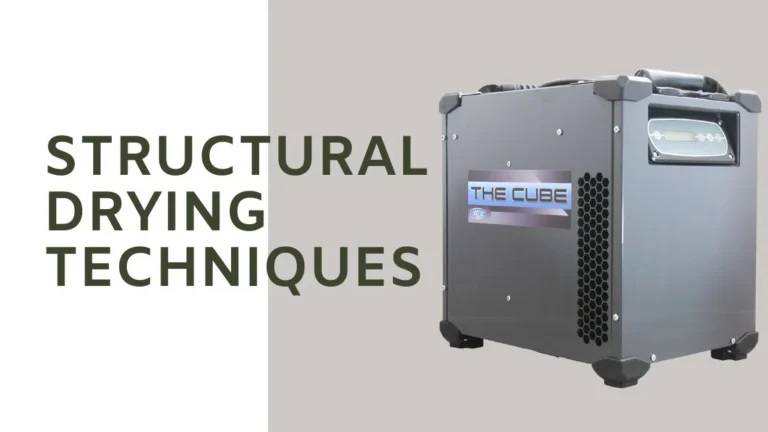After water damage, simply removing the water is not enough. Structural drying is a crucial process that ensures complete moisture removal and prevents further issues. In this article, we’ll explain the advantages of structural drying and why it’s essential for effective water damage restoration.
Structural drying is essential for mitigating water damage while preserving both safety and property value. This process involves comprehensive moisture assessment, targeted water extraction, and the use of advanced equipment such as industrial dehumidifiers and air movers to encourage rapid evaporation.
By efficiently removing excess moisture, structural drying helps prevent mould growth, enhances indoor air quality, and reduces restoration costs. It also safeguards personal belongings and maintains material integrity, making it a smart investment for property owners.
Key Takeaways
- Structural drying prevents mould growth by swiftly removing excess moisture, ensuring a healthier indoor environment.
- It minimises restoration costs and damage by facilitating timely recovery, thereby reducing the need for extensive repairs.
- The process enhances indoor air quality by eliminating moisture that fosters harmful microorganisms and allergens.
- Professional drying services preserve property value by protecting belongings and maintaining material integrity through effective moisture management.
- Quick intervention from experts reduces downtime and future complications, ensuring a safer and more comfortable living space.
Understanding Structural Drying
Structural drying is a critical response mechanism in the aftermath of water-related incidents, aimed at restoring buildings and materials to a safe and dry state. This process involves systematic moisture measurement and the application of advanced drying techniques.
Key stages include water extraction, airflow enhancement, dehumidification, and temperature control, each designed to facilitate efficient moisture removal. Learn more about understanding the effects of water damage.
Employing sophisticated equipment, such as moisture meters and industrial dehumidifiers, professionals can monitor the drying progress meticulously.
By addressing excess moisture promptly, structural drying not only mitigates the risk of mould and mildew proliferation but also safeguards the integrity of the structure.
As over 30% of homes experience water damage annually, understanding these processes is essential for effective recovery solutions that foster a sense of community and well-being.
Importance of Structural Drying
The importance of effective structural drying cannot be overstated, as it plays a pivotal role in safeguarding both the physical integrity of buildings and the health of their occupants.
Proper moisture management through advanced drying techniques is essential for a variety of reasons:
- Prevents Mould Growth: Timely removal of excess moisture reduces the risk of mould proliferation, ensuring a healthier living environment.
- Minimises Restoration Costs: Efficient drying prevents subsequent damage, greatly lowering repair expenses.
- Enhances Indoor Air Quality: By eliminating moisture that promotes harmful microorganisms, structural drying creates a safer atmosphere for all.
- Preserves Property Value: Protecting personal belongings and maintaining material integrity is vital for long-term investment stability.
These factors highlight the significant nature of structural drying in promoting safety and sustainability in our homes.
The Structural Drying Process
Effective management of moisture is a meticulous process that follows a systematic approach to guarantee thorough drying.
The structural drying process begins with a comprehensive moisture assessment, identifying the source of water and the extent of damage.
Water extraction is the initial critical step, employing specialised pumps to swiftly remove standing water.
Following this, high-powered fans and air movers implement advanced evaporation techniques, enhancing airflow to facilitate rapid moisture evaporation from affected materials.
Dehumidification plays an essential role, ensuring moisture is extracted from the air to prevent reabsorption and inhibit mould growth.
Continuous monitoring of humidity and moisture content is essential, culminating in a final inspection that confirms the complete removal of moisture, safeguarding safety and structural integrity.
Advanced Drying Equipment
Using advanced drying equipment significantly enhances the efficiency and effectiveness of moisture removal in affected structures.
Implementing state-of-the-art tools not only accelerates the drying process but also ensures a healthier environment.
Key components include:
- High-capacity industrial dehumidifiers: Optimise dehumidifier efficiency by effectively extracting moisture vapour from the air, preventing reabsorption and mould growth.
- Air mover technology: Circulates large volumes of air to create high-velocity airflow, speeding up evaporation from surfaces.
- Inject-dry systems: Target hidden moisture in walls and floors, ensuring comprehensive drying.
- Air scrubbers: Improve indoor air quality by eliminating airborne particles and pathogens during the drying process.
Together, these tools create a robust solution for effective structural drying, fostering a sense of security and well-being for occupants.
Benefits of Structural Drying
Structural drying offers numerous benefits that extend beyond mere moisture removal, fundamentally enhancing the resilience and livability of affected spaces.
Effective moisture management is vital in preventing mould growth, thereby safeguarding indoor air quality and reducing health risks associated with mould exposure.
By employing advanced drying techniques, property owners can minimise lingering moisture, greatly mitigating the risks of subsequent damage and costly repairs.
The time-efficient nature of professional structural drying guarantees a swift restoration process, allowing daily life and business operations to resume with minimal disruption.
Additionally, prioritising the preservation of essential building materials during drying not only maintains property value but also strengthens structural integrity, creating a safer and more comfortable environment for all occupants.
Professional Vs. DIY Drying
When confronted with water damage, the decision between professional structural drying services and DIY methods can significantly influence both effectiveness and cost.
Professionals possess specialised training and advanced equipment, ensuring a thorough and efficient drying process that reduces the risk of mould growth.
In contrast, DIY approaches may save on immediate expenses but often fail to address hidden moisture, potentially resulting in greater long-term costs and health risks.
Expertise and Equipment
Frequently, homeowners facing water damage are tempted to tackle drying efforts on their own, unaware of the significant advantages that professional services offer.
The expertise evaluation provided by professionals guarantees superior equipment effectiveness and thorough drying that DIY methods often lack.
Consider the following benefits of hiring experts:
- Specialised Equipment: Access to high-powered air movers and industrial dehumidifiers that are unavailable to homeowners.
- Accurate Assessments: Professionals can identify hidden moisture pockets that DIY efforts may overlook.
- Targeted Techniques: Tailored drying methods that address specific materials, minimising damage.
- Rapid Response: Quick intervention reduces downtime and prevents further structural damage.
Utilising professional services not only enhances the drying process but also safeguards your home from future complications.
Cost Considerations
Water damage can impose a heavy financial burden on homeowners, making cost considerations a critical factor in deciding between professional and DIY drying methods.
While DIY drying might initially appear to offer cost benefits, the risk of hidden moisture and potential mould growth can lead to considerably higher long-term expenses.
Professional services, equipped with advanced tools and expertise, effectively mitigate these risks, ensuring thorough drying that DIY methods often overlook.
Furthermore, many insurance policies provide coverage for professional drying costs, easing the financial strain during such crises.
Factors Affecting Drying Time
The efficiency of the drying process is largely determined by several key factors, including the volume of water present, the type of materials affected, and the environmental conditions.
Larger quantities of water necessitate more extensive drying efforts, while porous materials absorb moisture more deeply, prolonging drying time.
Furthermore, ideal temperature, humidity, and airflow can greatly enhance evaporation rates, underscoring the importance of these variables in the drying timeline.
Water Volume Impact
A significant factor influencing drying time in water damage scenarios is the volume of water present during the incident. The greater the volume, the more prolonged the drying process due to increased moisture retention in structural materials.
Key considerations include:
- Water Absorption Rates: Porous materials such as plasterboard and timber absorb water more readily, leading to extended drying times.
- Initial Extraction: Efficient removal of standing water is essential to prevent prolonged dampness.
- Environmental Conditions: Higher humidity can impede evaporation, while ideal temperatures (21-32°C) can expedite drying.
- Type of Water: Clean, grey, or black water impacts the drying timeline, with contaminated water requiring additional remediation efforts.
Understanding the impact of water volume allows for effective and timely restoration efforts.
Material Type Considerations
Understanding the nuances of material types is vital in optimising drying times following water damage. Different materials exhibit varying levels of absorption, greatly influencing the drying process.
For instance, porous materials like drywall and carpet typically require more time to dry compared to non-porous options such as metal or plastic. Moreover, materials with higher moisture retention, like wood, may necessitate specialised drying techniques to expedite the process.
Thickness also plays an important role; thicker materials can trap moisture, prolonging drying efforts. In addition, the elapsed time since water exposure is essential, as prolonged wetness can lead to mould growth and complicate drying.
Recognising these factors guarantees effective and efficient structural drying.
Environmental Conditions Influence
Environmental conditions significantly influence the efficiency and duration of structural drying processes.
Effective drying depends on several factors that must be taken into account to achieve optimal results:
- Temperature: Warmer air (21-32°C) enhances evaporation rates, facilitating quicker drying.
- Humidity Control: High humidity levels can saturate the air, considerably prolonging drying time.
- Air Circulation: Adequate airflow and ventilation are essential; stagnant air can trap moisture, resulting in slower drying.
- Water Volume: The amount of standing water initially present dictates drying duration; larger volumes necessitate more extensive extraction and evaporation efforts.
Mould Prevention Strategies
Effective mould prevention strategies are essential in safeguarding structural integrity and indoor air quality, especially in the aftermath of water damage. Mould growth can initiate within 24-48 hours if moisture control is inadequate. Employing advanced dehumidifiers to maintain humidity levels below 50% is crucial in inhibiting mould proliferation. Regular monitoring of moisture content in building materials is important, along with using air movers to enhance evaporation and air circulation, creating an environment unsuitable for mould. Furthermore, proper temperature control, ideally between 20-27°C, accelerates moisture removal.
| Strategy | Description |
|---|---|
| Dehumidification | Lowers humidity to inhibit mould growth |
| Air Movement | Enhances evaporation and reduces dampness |
| Temperature Management | Maintains ideal conditions for moisture control |
Contacting Restoration Services
In the event of water damage, timely intervention is crucial for property owners, as the consequences of inaction can be severe.
Contacting restoration services will ensure a swift emergency response, safeguarding your home and health.
Consider the following advantages:
- 24/7 Availability: Immediate assistance to address water damage incidents.
- Advanced Equipment: Experts utilise moisture meters and dehumidifiers for effective assessment and mitigation.
- Mould Risk Reduction: Prompt action minimises mould growth and structural damage.
- Insurance Implications: Many policies cover professional drying services, making expert help a financially sound choice.
If you need advice or support in relation to Structural Drying or have a question about potential water damage, please call PCLA today.



